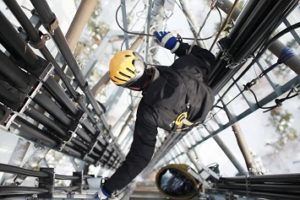It’s simple enough to identify the hazards of communication tower work: falls and structural collapses, rigging and hoisting practices, and struck-by hazards. What’s sticky is the question of who is responsible for workers’ safety in an industry that employs multiple layers of contractors.

morfous / iStock / Getty Images Plus / Getty Images
A new guidance document, jointly released by Occupational Safety and Health Administration (OSHA) and the Federal Communications Commission (FCC), Communication Tower Best Practices, identifies strategies for carriers and tower owners to ensure safety from the top to the bottom of the contract chain.
Multilevel Contracting and Safety
If the towers were owned and serviced by carriers, there would be a clear and direct line of responsibility from the employer to the employee. But that’s not how the communication tower industry works. The towers are often owned by corporations separate from carriers and are built by contractors. Carriers contract for the installation and maintenance of their equipment on towers through “turf vendors,” who then hire contractors of their own to do the work. Those contractors may hire subcontractors.
Thus, responsibility for worker safety is diffuse and sometimes unclear.
OSHA and the FTC recommend that a specific person be given responsibility for coordinating safety and health programs all along the contracting chain. The designated person should have direct personal experience with tower work or should have an experienced advisor.
The safety and health program should:
- Clearly delineate, for each party in the chain, what each one’s roles and responsibilities are in safeguarding employee safety and health.
- Require all lower-tier contractors to have written safety and health programs of their own.
- Make abiding by the defined roles and responsibilities a condition of awarding contracts.
- Establish concrete consequences for contractors that do not take appropriate steps to ensure the safety of their employees. In some instances, termination of the contract may be an appropriate consequence.
- Include provisions for regular review of contractor safety and health programs.
Vetting Contractors and Verifying Individual Employees
The communication tower industry is treading some new ground with respect to contractor safety and liability: the growing need to ensure that a contracted employee—who may have been hired by a subcontractor of a contractor who works for the company you have directly contracted with—is qualified to do the job safely. OSHA and the FCC offer recommendations for both vetting contractors and for verifying the credentials of individual workers. Carriers and tower owners can take these steps to vet contractors and subcontractors before hiring:
- Set consistent approval criteria for all contractors and subcontractors, including:
- Requiring prior written approval for any subcontracting
- Requiring contractors to provide access to, or maintain, certification and training records for each employee
- Requiring ongoing monitoring and evaluation of contractor safety records, including OSHA records
- Considering a contractor’s safety record in the awarding of future contracts
- Instituting independent (third-party) jobsite audits to ensure that the contractors are performing work using appropriate safety measures
- Authorize stop work authority for all employees, at all levels in the contracting chain. Any person should stop work on a project if unsafe conditions are discovered. There should be no repercussions or reprisals for doing so.
Tomorrow we’ll look at how overlapping and redundant responsibility can help to ensure the safety of workers in multilevel contracting situations.
